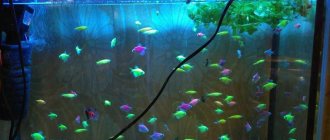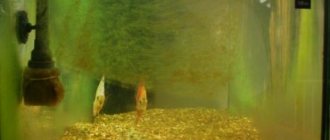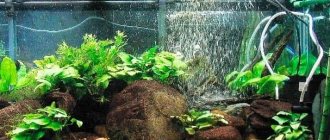Aquarium keeping is a complex hobby that requires taking into account many nuances at all stages of the life of fish. Even if the quantity and quality of light and food are maintained, and the water is changed on time, there is no guarantee that the inhabitants of the aquarium will live long, delight the user with colorful flowers, much less reproduce. After all, the balance of water composition consists of many components, changing from day to day. Chemicals can help optimize the aquatic environment. The editors of the YaNashla website bring to your attention a review of the best products and additives for aquarium water for 2021.
What determine the parameters of purity and transparency?
The purity and transparency of water in an aquarium depends on many criteria:
Volume . The smaller the container, the faster the water evaporates and becomes cloudy. The optimal volume is from 100 l.- Number of fish. The more “overpopulated” an aquarium is, the faster the water becomes polluted with fish waste products and other organic waste. As a result, it becomes cloudy and a film appears on the surface. The average volume of water per fish is 5 liters.
- Quality of the filtration system. The type of filter is not important. It can be mechanical, chemical, biological, mixed.
- Light and temperature conditions. Bright light and heat provoke the active development of microflora, the water begins to “bloom” and become cloudy.
- Presence of algae, snails . Many of them are useful as “live filters,” but it’s important not to overdo it. An excess of algae simply prevents the fish from moving in the aquarium, and the waste of many snails greatly exceeds the volume of organic matter they process.
- Regularity of water changes according to the “age” of the ecosystem. This is the only way to maintain its optimal biobalance, otherwise the water will inevitably become cloudy, despite the presence of “biological” and other filters and the use of special preparations.
- The quality of the water itself. To maintain clarity, tap water requires preliminary preparation before it can be poured into the aquarium. The most popular way is to defend it.
- Also, only fish should live in the aquarium. The only acceptable “neighbors” for them are snails. For turtles, newts, and Cuban frogs, you need to purchase a different container.
Is there a need to settle the water?
In order for tap water to be normalized for replacement in an aquarium, it is necessary to remove all harmful components from it - solid, gaseous and liquid.
Today, upholding is extremely rarely relevant. There are isolated cases of solid components in the water supply; derivatives of chlorine water have to be removed with an air conditioner (chlorine gas is also removed), but liquid components must be removed only with a special air conditioner. Contaminated water settles for several hours, and with strong aeration it settles much faster.
From all of the above, it is clear that it is best to use special water additives. Sedimentation of water does not completely remove harmful substances, and in some cases it can even be harmful (a dusty film appears, mustiness, etc.).
From personal experience:
- I collect the required amount of water for the change;
- I add conditioner according to the instructions;
- I perform aeration for 15 minutes;
- I bring the temperature of fresh water (with air conditioning) in line with the aquarium temperature;
- I fill it in and that’s it.
The advantages of this method of water preparation: all harmful substances are removed, there is no need to wait for the water to settle, the basins do not harm the interior of the room.
Helping tools
To ensure crystal clear aquarium water, you can use one of the following products:
Tetra Aqua Bactozym
Suitable for fresh and seawater aquariums, but the dosage varies - you must follow the manufacturer's instructions on the packaging. However, even if the recommended dose is exceeded, the aquarium fauna and flora will not be harmed.
The product not only purifies muddy water to crystal clarity, but also improves its quality for fish, activating the process of reproduction of microflora beneficial to them.
The drug helps:
- decompose organic waste (food remains, excrement, dead parts of plants),
- nitrogen compounds (ammonia, nitrates, nitrites - this is the strongest poison for fish),
- remove chlorine, fluorine, and heavy metal salts from tap water.
Add directly to water or to a filter (you can put the capsule itself or pour out its contents). The “cleaning” process lasts a day.
Aquarium Pharmaceuticals Stress Coat Accu-Clear
Specialized “turbidity precipitator” for aquarium water.
Cleans it from the smallest particles that form suspension and turbidity of various origins:
- priming,
- unicellular algae,
- bacteria.
They “stick together” into larger “clumps” that aquarium filters can already catch. completely safe for all inhabitants of the aquarium, does not affect the chemical composition of the water in any way, and is economically consumed.
The effectiveness of the drug is beyond doubt, but it is relatively rare in Russian stores; you have to place orders on foreign websites. The product is only suitable for freshwater aquariums; it is strongly recommended to avoid overdose.
Aquacons "Clean Water"
The conditioner is designed to eliminate water turbidity of any origin in a freshwater or marine aquarium. It copes with the massive development of pathogenic microflora, particles of silt and soil, unicellular algae, and “blooming” of water.
The product does not change the acid-base balance or its other parameters and is safe for aquarium flora and fauna.
The only negative point is that when using the drug, sediment in the form of flakes falls on the ground. These, in fact, are the smallest particles “glued together” by it. But it can be easily removed using a siphon or hose.
If the aquarium is not equipped with filtration and aeration systems, it is necessary to stir the water after adding conditioner. The average norm is 5 ml per 50 liters of water. When after half an hour no sediment appears, it is permissible to add a second dose (and so on up to five times).
TetraAqua CrystalWater
Suitable for freshwater aquariums. “Binds” the smallest particles floating in the water into larger ones, which can be caught by filters of any type. Or they settle to the bottom, then are removed by a siphon.
It is fast-acting - the first positive changes are noticeable after 2-3 hours , after 8-12 hours the water becomes crystal clear.
The product is suitable for water of any hardness and does not change its chemical parameters. It is colored yellow, so after using it the shade of the water changes for a short time, this is normal.
The product is effective against turbidity caused by microbiological imbalance, the development of pathogenic microflora, improper water replacement, and the presence of organic waste.
Important! The listed funds can be used both when starting an aquarium for the first time, when the biobalance in the ecosystem is just being established, and in the future, when changing the water to maintain its transparency. They are also effective for restoring biobalance after drug treatment of fish.
Features for Marine Vessel
Basic water preparation for an aquarium with sea water has the same rules as with fresh water.
The main difference is that so much sea salt should be added to the water so that its value is in the range of 1.021-1.024.
This water is prepared exclusively in plastic containers.
How to achieve it?
To obtain crystal clear water and maintain it in this condition, the aquarist requires regular and comprehensive actions. This applies to caring for both the fish and the aquarium itself.
Mechanical filtration
Filtration is the “basic” method of purifying water in an aquarium. A mechanical filter helps get rid of dirt and other debris.
All this is inevitably present in the water in the form of suspension and creates turbidity.
It absorbs water inside, the particles are retained in a layer of sponge and filter wool. The finer it is, the better the cleaning.
The aquarist only needs to select a filter whose size and performance correspond to the dimensions and volume of the aquarium. Only in this case can crystal clarity of water be achieved.
Reference! At each water change, the sponge or cotton wool inside is washed with the same water that is drained from the aquarium so that the beneficial microflora is not damaged.
Chemical filtration
The chemical filter works independently of the mechanical one; it adsorbs or absorbs those particles that, due to their size, “slip” through the sponge or cotton wool.
For aquariums, special carbon filters are used that look like a mesh bag. You just need to place it in water (based on the volume it is designed for). Filters are changed monthly. Being saturated with harmful substances, it no longer gives the desired effect.
Lighting
Excessively bright light provokes the rapid development of unicellular blue-green algae.
The water in the aquarium first turns slightly green, then becomes cloudy, turning into a kind of pea soup.
Having noticed this problem, the “daylight hours” are reduced to the recommended 10-12 hours a day. You can also reduce the power of the lamps.
The approximate norm is 10-15 W per 10 liters of water in an aquarium, if they are located on the side and 20% more powerful when placed above the surface of the water. Next, it is advisable to use a flocculant or carbon filter to purify the water. The first remedy will give results faster.
Advice! After the water returns to a state of crystal purity, it is recommended to replace conventional lamps with UV purifiers. They not only provide the aquarium with the necessary light, but also disinfect the water, destroying pathogenic microflora. Their only drawback is their high cost.
We recommend an article on the topic
Review of effective water conditioners for aquariums: features, cost, consumer opinions
Beneficial bacteria
Strains are sold in specialized stores for aquarists; they come in a small bottle or ampoule with liquid. It is added to the aquarium in the required proportion according to the instructions and lightly mixed. The bacteria begin working immediately.
They are most often used when starting a new aquarium, when the water inevitably becomes very cloudy. Bacteria allow the biobalance of the new ecosystem to settle much faster - in 7-10 days instead of 2-3 months.
Flocculant
A fairly effective method if you need to quickly purify water, but the effect is short-lived.
Flocculants purify H2O using electrical charges of minimal power.
They "glue" tiny particles together to such a size that they can be removed using a mechanical filter. It is absolutely safe for fish.
There are specialized preparations for fresh and sea water aquariums. The liquid is added to clean water strictly according to the dosage instructions, then the resulting solution is poured into the aquarium, trying to get to where the filtration and aeration systems provide maximum water movement.
Interesting! The cleaning process lasts for 12 hours. If crystal transparency cannot be achieved, you can repeat the procedure, but not earlier than in a day. It is allowed to use such drugs no more than twice in 5 days.
Stern
The clarity of the water in the aquarium is affected by both the type and volume of food. For each feeding, there is enough portion that the fish eat in 3-5 minutes. Otherwise, the residues settle to the bottom and begin to rot.
As for quality, it is preferable to choose granules than flakes; they produce less “waste”. It is strongly not recommended to feed fish with bread crumbs or raw meat. We also accept live food (bloodworms, daphnia), but here you need to take into account the size of the underwater fauna, otherwise the fish simply will not be able to swallow it.
Fish
Some inhabitants of the aquarium belong to the category of “bottom-dwelling” fish. They simply “plow” the soil at the bottom in search of food.
First of all, this applies to:
- goldfish,
- cichlids
- corridoros (catfish).
It is very difficult to get rid of cloudy suspended matter in water with such inhabitants. The aquarium requires enhanced filtration and especially powerful filters.
Changing water
A vital procedure for any aquarium. The frequency of its implementation and the volume of replaced water depend on the “age” of the ecosystem, the volume of the aquarium, the number of fish, the quality of filtration systems and the water used.
In an aquarium up to a year old, you need to change it monthly by 20-25% . If everything is in order with its transparency - by 10%. When the ecosystem is older - in the same volume, but with a frequency of 2 weeks.
Reference! Use only settled water. It is poured into the aquarium after cleaning, without “evicting” fish and other fauna from it. This is done carefully, in small portions, so as not to raise suspended matter from the bottom.
Cleaning the tank
This must be done every time you change the water.
Cleaning includes the following steps:
All decor is removed from the aquarium, thoroughly washed in a solution of table salt or baking soda (25-30 g/l) or potassium permanganate (bright pink).
If necessary, clean with a brush. Then rinse in the water drained from the aquarium during the change.- Use a scraper or brush to go along the walls of the aquarium, removing the existing greenish coating and mucus.
- Carry out mechanical cleaning of filters.
- Get rid of broken, dead, rotting algae. Others, if they have clearly grown, are pruned and thinned out.
- Clean the substrate at the bottom. You need to go through it with a siphon.
Attention! To clean any elements of the aquarium ecosystem, do not use soap or household chemicals.
How to keep it clean?
To maintain the crystal purity of water in the aquarium, in addition to the measures described above, experienced aquarists recommend the following measures:
- Cover the aquarium with a lid of a suitable size to prevent dust and dirt from getting inside. But at the same time, for normal air exchange it is necessary to leave a small gap.
- Constantly monitor “population density.”
- Rationize food. It is easy to determine the required portion for a “one meal” experimentally and stick to it in the future.
- Regularly inspect the aquarium, monitor the state of the ecosystem, and immediately get rid of dead algae and dead fauna. You should also not allow any objects or substances that are not intended for the aquarium to get into the water.
- Everything that is planned to be placed in the aquarium (soil, decorative elements, new algae) should be thoroughly washed beforehand, and if this is permissible, also disinfected (for example, in boiling water).
- Monitor the temperature and the length of daylight hours.
- Plant algae that are easy to maintain, not prone to active growth and capable of purifying water - for example, hygrophila, vallisneria, ambulia.
Important!
Sand is not the most suitable soil for an aquarium. It is this that often produces sediment, which causes cloudiness in the water. It is strongly not recommended to fertilize the substrate at the bottom unless absolutely necessary.
Why do you need to settle water?
The main reason for this is harmful impurities that can harm the inhabitants of our aquarium. After settling, solid particles sometimes appear and precipitate. Initially clear water may become cloudy after some time.
Many aquarists leave the water for replacement to breathe for several days, and to ensure that all harmful suspensions have evaporated, for a week. This assumption is partially true, but it cannot guarantee the quality of the prepared water.
Before we do something, we always know why we need to do it. By keeping tap water out of the pipeline, we are trying to improve its characteristics so that it does not harm our fish. In other words, when water settles, we get rid of most of the harmful components.
Conditionally harmful substances found in water can be divided into:
- solid (sediment falls to the bottom);
- gaseous (evaporate from water into the environment);
- liquid (initially dissolved and remaining in water).
The settling process can only affect solid and gaseous mixtures, and it does not affect liquid substances in any way.











